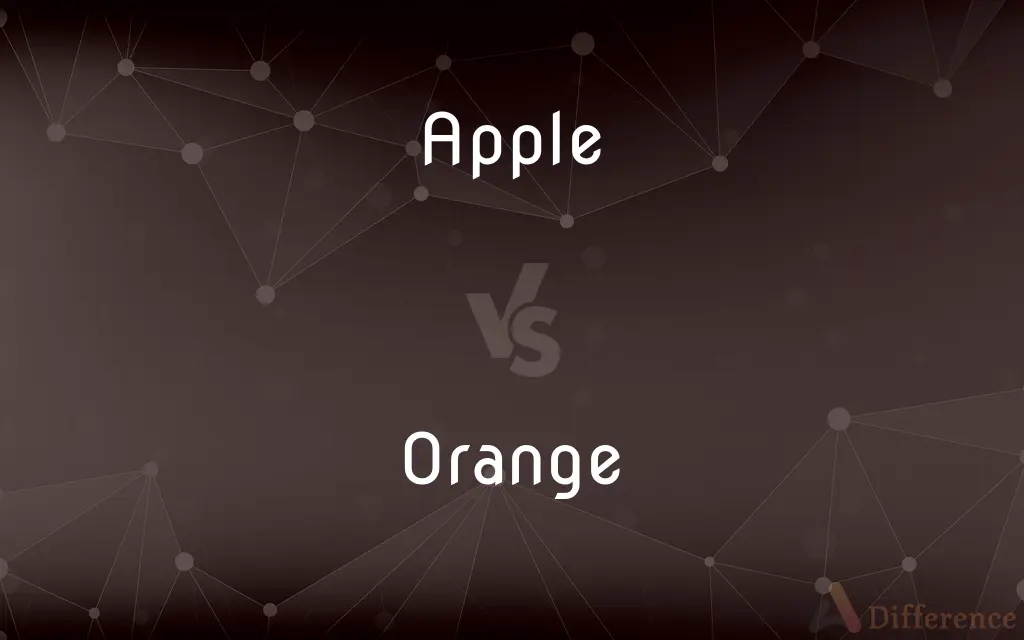Apple vs. Orange — What's the Difference?
Edited by Tayyaba Rehman — By Maham Liaqat — Updated on March 20, 2024
Apple is a temperate fruit with a sweet flavor and firm texture, commonly eaten fresh or used in desserts, while orange is a citrus fruit known for its vibrant color, juicy segments, and a blend of sweet and tangy flavors, often consumed fresh juices.

Difference Between Apple and Orange
Table of Contents
ADVERTISEMENT
Key Differences
Apples are cultivated in temperate regions and are known for their wide variety of types and flavors, ranging from sweet to tart. They have a firm flesh and can be eaten raw or used in cooking. Oranges, on the other hand, thrive in subtropical to tropical climates, offering a juicy, sweet, and sometimes slightly sour taste. They are primarily consumed fresh or as juice.
The skin of an apple is thin and edible, with colors varying from red to green and yellow, depending on the variety. Oranges have a thicker, pebbly skin that is often bright orange, protecting the juicy segments inside. The skin of an orange is commonly zested to add flavor to dishes.
Apples are often associated with health benefits, such as fiber content and antioxidants, and are linked to improving heart health and reducing the risk of diabetes. Whereas oranges are renowned for their high vitamin C content, supporting immune function and skin health.
In terms of culinary uses, apples are versatile, used in pies, crisps, salads, and as snacks. Oranges are equally versatile but shine in different areas, like juices, marmalades, and as a fresh addition to salads or as a snack.
Apples can be stored for a longer period, especially when kept cool, which makes them available year-round. Oranges, while also having a decent shelf life, tend to have a more pronounced seasonality, with peak seasons varying by variety.
ADVERTISEMENT
Comparison Chart
Climate
Temperate
Subtropical to tropical
Taste
Ranges from sweet to tart
Sweet and tangy
Skin
Thin, edible, varies in color
Thick, pebbly, usually orange
Health Benefits
High in fiber and antioxidants
High in vitamin C
Culinary Uses
Eaten raw, cooking, desserts
Eaten raw, juicing, flavoring
Storage
Longer shelf life, especially when kept cool
Decent shelf life, seasonal
Compare with Definitions
Apple
A fruit with a sweet to tart taste, depending on the variety.
The apple pie we had for dessert was made with freshly picked apples.
Orange
High in vitamin C and supports immune function.
Drinking orange juice can help boost your vitamin C intake.
Apple
Can be stored for a relatively long period.
Stored in a cool place, apples can last for months.
Orange
A citrus fruit known for its juicy segments and sweet-tangy flavor.
Fresh orange juice is a staple at breakfast.
Apple
Consumed both fresh and in various dishes.
She added thin apple slices to the salad for a sweet crunch.
Orange
Oranges are versatile in culinary uses, from juicing to salads.
She topped the dessert with candied orange slices for a citrusy contrast.
Apple
Available in many varieties and colors.
The gala apples are especially sweet and perfect for snacking.
Orange
The peel is often used as zest in recipes.
The recipe called for the zest of one orange to enhance the flavor.
Apple
Known for its health benefits, including fiber and antioxidants.
Eating an apple a day is good for your heart health.
Orange
Grows in subtropical to tropical climates.
Florida is a major producer of oranges in the United States.
Apple
An apple is an edible fruit produced by an apple tree (Malus domestica). Apple trees are cultivated worldwide and are the most widely grown species in the genus Malus.
Orange
A town in southern France, on the River Rhône, home of the ancestors of the Dutch royal house.
Apple
The round fruit of a tree of the rose family, which typically has thin green or red skin and crisp flesh.
Orange
Relating to the Orange Order
Orange marches
Apple
The tree bearing apples, with hard pale timber that is used in carpentry and to smoke food.
Orange
Any of several evergreen trees of the genus Citrus of Southeast Asia, widely cultivated in warm regions and having fragrant white flowers and round fruit with a yellowish or reddish rind and a sectioned, pulpy interior, especially the sweet orange and the bitter orange.
Apple
A cultivated deciduous tree (Malus domestica or M. pumila) in the rose family, native to Eurasia and having alternate simple leaves and white or pink flowers.
Orange
The fruit of any of these trees, having a sweetish, acidic juice.
Apple
The firm, edible, usually rounded fruit of this tree.
Orange
Any of several similar plants, such as the Osage orange and the mock orange.
Apple
Any of several other plants, especially those with fruits suggestive of the apple, such as the crabapple or custard apple.
Orange
The hue of that portion of the visible spectrum lying between red and yellow, evoked in the human observer by radiant energy with wavelengths of approximately 590 to 630 nanometers; any of a group of colors between red and yellow in hue, of medium lightness and moderate saturation.
Apple
The fruit of any of these plants.
Orange
Of the color orange.
Apple
A common, round fruit produced by the tree Malus domestica, cultivated in temperate climates.
Orange
Made from oranges.
Apple
Any fruit or vegetable, or any other thing produced by a plant such as a gall or cone, especially if produced by a tree and similar to the fruit of Malus domestica; also (with qualifying words) used to form the names of specific fruits such as custard apple, rose apple, thorn apple etc.
Orange
Tasting or smelling like oranges.
Apple
Something which resembles the fruit of Malus domestica, such as a globe, ball, or breast.
Orange
(countable) An evergreen tree of the genus Citrus such as Citrus sinensis.
Apple
The ball in baseball.
Orange
(countable) The fruit of the orange tree; a citrus fruit with a slightly sour flavour.
Apple
(informal) When smiling, the round, fleshy part of the cheeks between the eyes and the corners of the mouth.
Orange
The colour of a ripe fruit of an orange tree, midway between red and yellow.
Apple
The Adam's apple.
Orange
Various drinks:
Apple
(Christianity) The fruit of the Tree of Knowledge, eaten by Adam and Eve according to post-Biblical Christian tradition; the forbidden fruit.
Orange
(uncountable) Orange juice.
Apple
A tree of the genus Malus, especially one cultivated for its edible fruit; the apple tree.
Orange
(uncountable) An orange-coloured and orange-flavoured cordial.
Apple
The wood of the apple tree.
Orange
(uncountable) An orange-coloured and orange-flavoured soft drink.
Apple
Short for apples and pears, slang for stairs.
Orange
Having the colour of the fruit of an orange tree; yellowred; reddish-yellow.
Apple
A Native American or red-skinned person who acts and/or thinks like a white (Caucasian) person.
Orange
(transitive) To color orange.
Apple
An assist.
Orange
(intransitive) To become orange.
Apple
(slang) A CB radio enthusiast.
Orange
The fruit of a tree of the genus Citrus (Citrus Aurantium). It is usually round, and consists of pulpy carpels, commonly ten in number, inclosed in a leathery rind, which is easily separable, and is reddish yellow when ripe.
Apple
(ambitransitive) To make or become apple-like.
Orange
The tree that bears oranges; the orange tree.
Apple
(obsolete) To form buds, bulbs, or fruit.
Orange
The color of an orange; reddish yellow.
Apple
The fleshy pome or fruit of a rosaceous tree (Pyrus malus) cultivated in numberless varieties in the temperate zones.
Orange
Of or pertaining to an orange; of the color of an orange; reddish yellow; as, an orange ribbon.
Apple
Any tree genus Pyrus which has the stalk sunken into the base of the fruit; an apple tree.
Orange
Round yellow to orange fruit of any of several citrus trees
Apple
Any fruit or other vegetable production resembling, or supposed to resemble, the apple; as, apple of love, or love apple (a tomato), balsam apple, egg apple, oak apple.
Orange
Any of a range of colors between red and yellow
Apple
Anything round like an apple; as, an apple of gold.
Orange
Any citrus tree bearing oranges
Apple
To grow like an apple; to bear apples.
Orange
Any pigment producing the orange color
Apple
Fruit with red or yellow or green skin and sweet to tart crisp whitish flesh
Orange
A river in South Africa that flows generally westward to the Atlantic Ocean
Apple
Native Eurasian tree widely cultivated in many varieties for its firm rounded edible fruits
Orange
Similar to the color of a ripe orange
Common Curiosities
Can you eat the skin of apples and oranges?
Apple skins are edible and often consumed with the fruit, whereas orange skins are usually not eaten but can be used as zest.
What are the main health benefits of apples and oranges?
Apples are high in fiber and antioxidants, while oranges are renowned for their vitamin C content.
How are apples and oranges used in cooking?
Apples are versatile, used in desserts, salads, and as snacks. Oranges are great for juicing, marmalades, and adding a fresh, citrusy note to dishes.
What is the shelf life of apples and oranges?
Apples can be stored for a long period, especially when kept cool. Oranges have a decent shelf life but are more seasonal.
What climates do apples and oranges grow in?
Apples grow in temperate climates, while oranges require subtropical to tropical conditions.
Are there different varieties of apples and oranges?
Yes, both fruits come in many varieties, each with its own unique taste and characteristics.
What tastes can you expect from apples and oranges?
Apples can range from sweet to tart, while oranges are known for their sweet and tangy flavor.
Can the nutritional content of apples and oranges support health?
Yes, apples can improve heart health and reduce diabetes risk, while oranges support immune function and skin health.
Is there a best time of year to buy apples and oranges?
Apples are generally available year-round, but oranges have peak seasons depending on the variety.
Are apples or oranges more versatile in recipes?
Both are versatile, but apples are more commonly used in baking, while oranges are prominent in juices and as flavor enhancers.
What distinguishes the taste of an apple from an orange?
The taste of an apple varies from sweet to tart and is less juicy compared to the sweet and tangy, more juicy orange.
Do apples and oranges need to be refrigerated?
Apples benefit from cool storage for longevity, while oranges can be stored at room temperature or refrigerated depending on preference and how quickly they'll be eaten.
How do the skins of apples and oranges differ?
Apple skins are thin and edible, with varying colors. Orange skins are thick, pebbly, and often used for zest.
Can both fruits be eaten raw?
Yes, both apples and oranges can be consumed fresh.
How do apples and oranges contribute to a balanced diet?
Both fruits offer essential nutrients and can be part of a healthy, balanced diet.
Share Your Discovery

Previous Comparison
Plain vs. Prairie
Next Comparison
Procurement vs. PurchaseAuthor Spotlight
Written by
Maham LiaqatEdited by
Tayyaba RehmanTayyaba Rehman is a distinguished writer, currently serving as a primary contributor to askdifference.com. As a researcher in semantics and etymology, Tayyaba's passion for the complexity of languages and their distinctions has found a perfect home on the platform. Tayyaba delves into the intricacies of language, distinguishing between commonly confused words and phrases, thereby providing clarity for readers worldwide.
















































